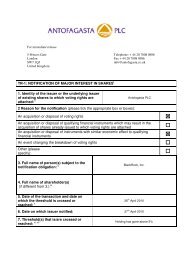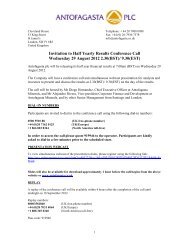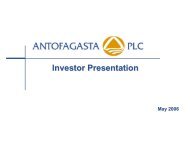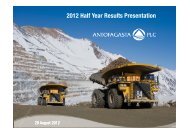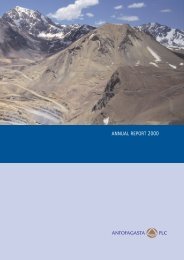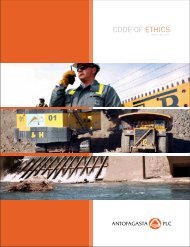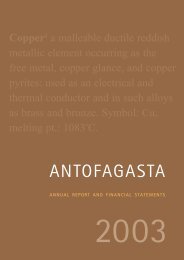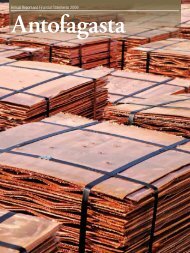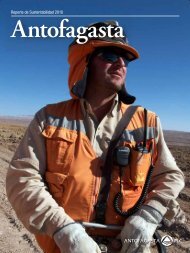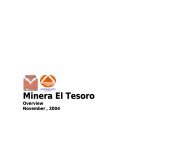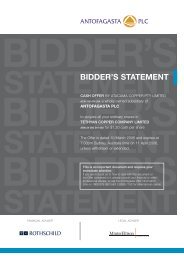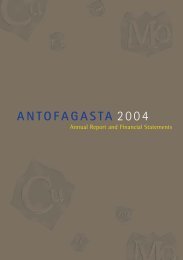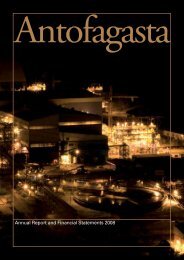Sustainability Report - Antofagasta PLC
Sustainability Report - Antofagasta PLC
Sustainability Report - Antofagasta PLC
You also want an ePaper? Increase the reach of your titles
YUMPU automatically turns print PDFs into web optimized ePapers that Google loves.
36<br />
<strong>Antofagasta</strong> plc <strong>Sustainability</strong> <strong>Report</strong> 2011<br />
Employees and labour relations<br />
Labour relations<br />
<strong>Antofagasta</strong> Minerals aims to maintain constructive relationships with its<br />
workers and the six labour unions that represent them through regular<br />
communication and consultation. Labour representatives are involved in<br />
decision-making that affects the workforce as early as possible. There<br />
were no labour disputes among employees or contractors during 2011.<br />
Collective agreements are in place at all mining operations that cover<br />
remuneration and terms and conditions of employment. Most of<br />
<strong>Antofagasta</strong> Minerals’ employees are unionised and any employment<br />
benefits agreed with unions are given to non-unionised employees as well.<br />
In 2011, there were four collective bargaining processes with unions at<br />
the operations, which were all successful. The agreements covered<br />
salaries, working hours, the terms of variable bonuses and employment<br />
benefits. The mining companies discuss collective agreements with union<br />
representatives before they are due for renewal.<br />
Percentage of workers unionised<br />
Los Pelambres<br />
Esperanza<br />
El Tesoro<br />
Michilla<br />
2011<br />
57%<br />
56%<br />
66%<br />
60%<br />
2010<br />
65%<br />
44%<br />
71%<br />
62%<br />
2009<br />
59%<br />
56%<br />
68%<br />
68%<br />
Employees are encouraged to voice their concerns through meetings with<br />
human resources managers at the operations. The mining companies<br />
keep a record of concerns raised by union and non-union employees to<br />
make sure they are investigated and addressed promptly.<br />
Mine managers keep employees informed about the business through a<br />
range of channels, including the intranet, newsletters, bulletin boards and<br />
social events.<br />
Employee satisfaction is monitored every year through a labour climate<br />
survey and on average across the mining companies 96% of workers<br />
responded to the survey in 2011. We are pleased that worker satisfaction<br />
in 2011 remained stable at 80%. The survey results at each mine are<br />
shared with operational managers, and managers of teams with lower<br />
than average satisfaction scores are required to develop improvement<br />
plans. Human resources managers support this process and monitor the<br />
effectiveness of any changes made.<br />
Talent, training and development<br />
Training for employees enables us to keep improving the skills of our<br />
workforce in line with the current and future needs of the business.<br />
Providing personal development opportunities helps to motivate<br />
employees and keep them with the company long term. Supervisors are<br />
responsible for identifying the skills and competencies that their workers<br />
need through annual performance meetings, and for supporting them in<br />
fulfilling these needs. The central budget available for training and<br />
development in 2012 has increased by around 30%.<br />
Corporate training programmes in 2011 included training managers at<br />
four levels (trainee, first-time manager, middle manager and senior<br />
manager) to develop their leadership capabilities through the <strong>Antofagasta</strong><br />
Minerals management diploma. The programme is delivered with the<br />
Adolfo Ibáñez University School of Business and was completed by 118<br />
employees in 2011.<br />
In 2011, the average number of training hours per person increased at El<br />
Tesoro, Los Pelambres and Michilla. To ensure it had the necessary<br />
workforce to operate, Esperanza trained a large number of new<br />
apprentices during its construction in 2010. Its training hours decreased<br />
significantly in 2011 with the completion of the apprentice programme.<br />
See case study on boosting local employment, page 46.<br />
Average hours of training per person (own employees)<br />
Los Pelambres<br />
Esperanza<br />
El Tesoro<br />
Michilla<br />
Corporate Centre<br />
2011<br />
372*<br />
179*<br />
54*<br />
53<br />
36<br />
2010<br />
267<br />
418<br />
34<br />
48<br />
22<br />
* Includes hours of training for mining apprenticeship programmes.<br />
2009<br />
264<br />
72<br />
29<br />
35<br />
19



